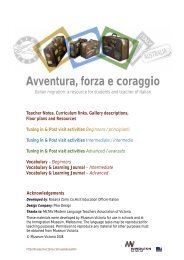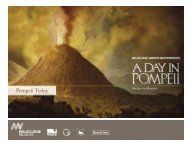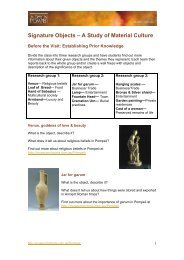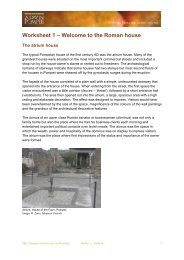Exhibition notes for A Day in Pompeii - Museum Victoria
Exhibition notes for A Day in Pompeii - Museum Victoria
Exhibition notes for A Day in Pompeii - Museum Victoria
You also want an ePaper? Increase the reach of your titles
YUMPU automatically turns print PDFs into web optimized ePapers that Google loves.
http://museumvictoria.com.au/<strong>Pompeii</strong><br />
<strong>Exhibition</strong> Notes<br />
PUBLIC BATHS<br />
Leisure time <strong>in</strong> cosmopolitan <strong>Pompeii</strong><br />
Bath<strong>in</strong>g <strong>in</strong> <strong>Pompeii</strong> was a public activity, not a private one, and the public baths were<br />
important social meet<strong>in</strong>g places. They were so important, <strong>in</strong> fact, that <strong>Pompeii</strong> (which<br />
had only 12,000 residents) boasted three major bath<strong>in</strong>g complexes: the Stabian baths,<br />
which were the oldest; the Forum baths, built after 80 BC; and the Suburban baths, built<br />
<strong>in</strong> the early first century AD. A fourth, the Central baths, was under construction, but was<br />
still <strong>in</strong>complete at the time of the 79 AD eruption.<br />
At the baths, men and women had separate areas; if there were no separate facilities,<br />
women bathed <strong>in</strong> the morn<strong>in</strong>g and men <strong>in</strong> the afternoon. In addition to the ma<strong>in</strong> bath<strong>in</strong>g<br />
block, which had facilities <strong>for</strong> hot, warm and cold bath<strong>in</strong>g, there was usually an adjo<strong>in</strong><strong>in</strong>g<br />
gymnasium <strong>for</strong> exercise. After the aqueduct system was built and a plentiful water<br />
supply was assured, an open-air swimm<strong>in</strong>g pool was even added to the Stabian baths.<br />
The procedure most Pompeians followed was to undress <strong>in</strong> the apodyterium, oil their<br />
bodies and then exercise <strong>in</strong> the gymnasium. After exercis<strong>in</strong>g, oil and sweat was scraped<br />
off with a curved tool called a strigil, then followed up with a series of baths, start<strong>in</strong>g <strong>in</strong><br />
the hottest pool and work<strong>in</strong>g their way via the warm pool to end with a brac<strong>in</strong>g dip <strong>in</strong> the<br />
cold pool. Furnaces beh<strong>in</strong>d the hot rooms supplied the heat <strong>for</strong> the hot baths; it<br />
circulated under the hollow floors and rose up through cavities <strong>in</strong> the walls, f<strong>in</strong>ally<br />
escap<strong>in</strong>g by means of chimneys <strong>in</strong> the vault.<br />
PRIVATE RESIDENCES<br />
What does a 2,000-year-old house look like, anyway?<br />
In some ways, Pompeian houses were very different to those we live <strong>in</strong> today. For one<br />
th<strong>in</strong>g, <strong>in</strong> <strong>Pompeii</strong>, all the liv<strong>in</strong>g rooms of the house faced <strong>in</strong>ward. Instead of hav<strong>in</strong>g a front<br />
garden or even a gate, the front door opened directly onto the pavement, and the rooms<br />
to either side of the door were usually either utility rooms or a shopfront. From the front<br />
door, a passage led back to the largest room <strong>in</strong> the house, the atrium, which was lit by a<br />
rectangular aperture (compluvium) <strong>in</strong> the middle of its high, wooden roof. Ra<strong>in</strong>water fell<br />
through this open skylight <strong>in</strong>to a rectangular bas<strong>in</strong> (impluvium) <strong>in</strong> the floor beneath, and<br />
ran <strong>in</strong>to a storage cistern under the floor — an arrangement similar to our modern water<br />
tanks, though almost certa<strong>in</strong>ly more attractive! Private rooms, which often conta<strong>in</strong>ed<br />
couches, were situated to either side of the atrium, and at the far end lay the three most<br />
important rooms: the outer tricl<strong>in</strong>ia, or d<strong>in</strong><strong>in</strong>g rooms, and the central tabl<strong>in</strong>um, a <strong>for</strong>mal<br />
reception room used by the master of the house <strong>for</strong> bus<strong>in</strong>ess and greet<strong>in</strong>g guests.<br />
The doors to the house were thrown open at an early hour to admit the family<br />
dependents (clientes) who had been wait<strong>in</strong>g patiently on the benches beside the front<br />
door.<br />
Pompeian architecture was clearly more homogeneous than our modern houses today;<br />
most, if not all, of the private dwell<strong>in</strong>gs found <strong>in</strong> the city con<strong>for</strong>m to this basic Roman<br />
layout. However, the wealthier citizens of <strong>Pompeii</strong> were <strong>in</strong> many ways as attuned to style<br />
and fashion as we are today, and newer houses were built to con<strong>for</strong>m to the latest<br />
trends.<br />
The so-called First Pompeian Style used the <strong>for</strong>mal, austere atrium as a showplace to<br />
impress visitors with grand decorations of moulded plaster pa<strong>in</strong>ted to imitate polychrome<br />
marble blocks. All manner of bus<strong>in</strong>ess was conducted <strong>in</strong> the atrium, so it was designed<br />
3






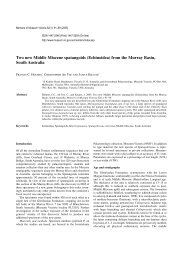

![[PDF] Andiamo a Pompei- Teacher Notes ... la - Museum Victoria](https://img.yumpu.com/16309810/1/190x245/pdf-andiamo-a-pompei-teacher-notes-la-museum-victoria.jpg?quality=85)
